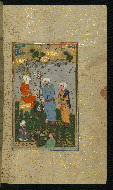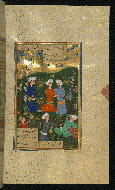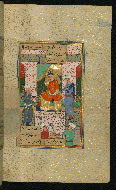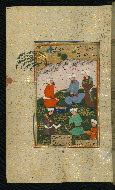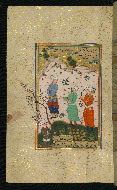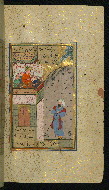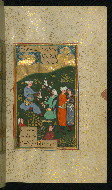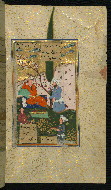Home > Digitized Walters Manuscripts
This document is a tranformation of a TEI P5 XML manuscript description incorporating images. If you have trouble reading special or non-Latin characters on this page, please make sure you have appropriate Unicode fonts installed and an up-to-date web browser.
Walters Ms. W.640, Collection of poems (divan)
Browse images (Browse images in a new window) | TEI in XML format
W.640
Collection of poems (divan)
Vernacular: ديوان جامى
Authority name: Jāmī, 1414-1492
As-written name: Nūr al-Dīn ʿAbd al-Raḥmān ibn Aḥmad Jāmī
Name, in vernacular: نور الدين عبد الرحمان بن احمد جامى
Note: Author dates preferred by cataloger: d. 898 AH / 1492 CE
This is an illuminated and illustrated Safavid copy of the first collection of poetry (Dīvān-i avval or Fātiḥat al-shabāb) by Nūr al-Dīn Jāmī (d. 898 AH / 1492 CE). According to the colophon, is was copied by the illustrious Safavid calligrapher Shāh Maḥmūd Nīshāpūrī (d. 972 AH / 1564-5 CE) (fol. 306a). The codex opens with a double-page illustrated frontispiece (fols. 1b-2a), which is followed by a double-page illuminated incipit (fols. 2b-3a). There are ten additional paintings that appear to date later than the text itself. These paintings are in the style of Isfahan in the eleventh century AH / seventeenth CE. The textblock, which has been trimmed, is bound in lacquer boards decorated with hunting scenes and landscape motifs. The binding was also executed in Iran and is attributable to the late tenth century AH / sixteenth CE or eleventh century AH / seventeenth CE. There are several erased seals and one ownership statement on fol. 1a, and a seal impression naming Muḥammad Amīn is found on fol. 3a.
10th century AH / 16th CE
Iran
As-written name: Shāh Maḥmūd Nīshābūrī
Name, in vernacular: شاه محمود نيشابورى
Note: Shāh Maḥmūd Nīshāpūrī (d. 972 AH / 1564-5 CE) was a poet and one of the three greatest Safavid calligraphers (see bibliography).
Book
Literary -- Poetry
The primary language in this manuscript is Persian.
- Transliteration: tamma bi-al-khayr /1/ katabahu al-ʿabd Shāh Maḥmūd Nishābūrī /2/ ghafara dhunūbahu wa-satara ʿuyūbahu /3/
- Comment: Gives the name of the scribe only
Paper
Laid paper with gold-sprinkled margins
Foliation: i+306+i
16.5 cm wide by 27.0 cm high
7.0 cm wide by 15.5 cm high
- Columns: 2
- Ruled lines: 15
- Framing lines in blue, red, mustard, green, and gold
- Title: Dīvān-i Jāmī
- Author: Jāmī, 1414-1492
- Scribe: Shāh Maḥmūd Nīshābūrī
- Incipit: بسم اله الرحمن الرحيم هست صلاى سر خوان كريم...
- Text note: Codex begins with a preface (fols. 1b-7a) composed in 884 AH / 1479 CE; first qaṣīdah begins on fol. 7a
- Hand note: Written in nastaʿlīq script in black, red, and blue
- Decoration note: Ten illustrations; double-page illustrated frontispiece (fols. 1b-2a); double-page illuminated incipit (fols. 2b-3a); headpiece introducing ghazals (fol. 66b), panels in the text, framing lines in blue, red, mustard, green, and gold
Upper board outside:
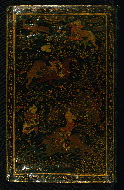
- Title: Lacquer binding
- Form: Binding
- Label: This Safavid lacquer binding is decorated with hunting scenes and landscape motifs. It is attributable to the late tenth century AH / sixteenth CE or eleventh century AH / seventeenth CE.
Upper board inside:
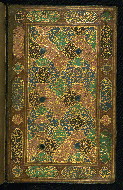
- Title: Doublure
- Form: Binding
- Label: This is a doublure of multicolored filigree work and mirror work that is attributable to the late tenth century AH / sixteenth CE or eleventh century AH / seventeenth CE.
fol. 1b:
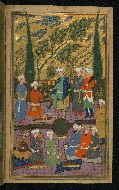
- Title: Double-page illustrated frontispiece
- Form: Illustration; frontispiece
- Label: This is the right side of a double-page illustrated frontispiece.
fol. 2a:
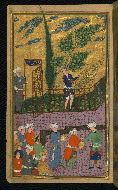
- Title: Double-page illustrated frontispiece
- Form: Frontispiece; illustration
- Label: This is the left side of a double-page illustrated frontispiece.
fol. 2b:
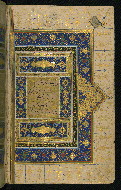
- Title: Double-page illuminated incipit
- Form: Incipit
- Label: This is the right side of a double-page illuminated incipit.
fol. 3a:
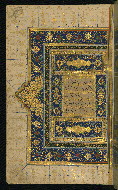
- Title: Double-page illuminated incipit
- Form: Incipit
- Label: This is the left side of a double-page illuminated incipit.
fol. 66a:
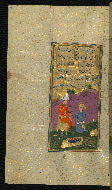
- Title: Offering of wine in a landscape
- Form: Illustration
- Label: This illustration marks the end of the section of qaṣīdahs.
fol. 66b:
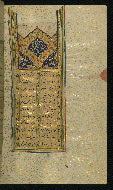
- Title: Incipit page with illuminated headpiece
- Form: Incipit; headpiece
- Label: This incipit page with illuminated headpiece, interlinear decoration, and gold-sprinkled margins introduces the section on ghazals.
fol. 72b:
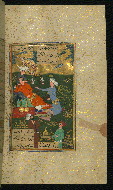
- Title: The poet Jāmī reciting poetry
- Form: Illustration
- Label: Jāmī, who is seen in the lower right corner in a brown robe, recites his poetry before others.
fol. 90b:
fol. 115b:
fol. 148b:
fol. 184a:
fol. 198a:
fol. 223b:
fol. 246b:
fol. 281b:
The binding is not original.
Perhaps late tenth century AH / sixteenth CE or eleventh century AH / seventeenth CE; lacquer boards (with flap) decorated with hunting scenes and landscape motifs; doublures of multicolored filigree work and mirror work
Several erased seals and one ownership statement (fol. 1a)
Seal impression with the name Muḥammad Amīn (fol. 3a)
Walters Art Museum, 1931, by Henry Walters bequest
Rieu, Charles. Catalogue of the Persian Manuscripts in the British Museum, vol. 2. (London: British Museum, 1879-83), 643.
Richard, Francis. Catalogue des manuscrits persans. (Paris: Bibliothèque nationale, 1989), no. 225.
Simpson, Marianna Shreve, and Massumeh Farhad. Sultan Ibrahim Mirza's Haft Awrang: A Princely Manuscript from Sixteenth-Century Iran. (Washington, D.C.: Freer Gallery of Art, 1997), 254-269.
Ibrāhīmī Ḥusaynī, Aḥmad. Calligraphers and Painters: A Treatise by Qāḍī Aḥmad, Son of Mīr-Munshī, circa A.H. 1015 / A.D. 1606, Translated from the Persian by V. Minorsky, with an Introduction by B.N. Zakhoder; Translated from the Russian by T. Minorsky. (Washington, D.C.: Smithsonian Institution, Freer Gallery of Art, 1959), 135-8.
Principal cataloger: Gacek, Adam
Catalogers: Landau, Amy; Smith, Sita
Editor: Bockrath, Diane
Conservators: Jewell, Stephanie; Quandt, Abigail
Contributors: Barrera, Christina; Emery, Doug; Herbert, Lynley; Noel, William; Simpson, Shreve; Tabritha, Ariel; Toth, Michael B.; Valle, Chiara
The Walters Art Museum
Licensed for use under Creative Commons Attribution-NonCommercial-ShareAlike 3.0 Unported Access Rights, http://creativecommons.org/licenses/by-nc-sa/3.0/legalcode. It is requested that copies of any published articles based on the information in this data set be sent to the curator of manuscripts, The Walters Art Museum, 600 North Charles Street, Baltimore MD 21201.
